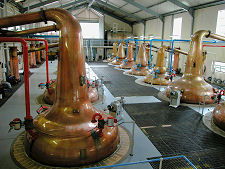 Financial Services: Edinburgh |
Scotland has a mixed economy closely interlinked with the rest of the United Kingdom (UK) and with the European Union more widely. Its Gross Domestic Product (GDP) per capita, which stood at £16,944 in 2005, is the 4th highest of the regions and countries of the UK, after London, South-East England and Eastern England. Its annual economic growth in 2006 was 2.2%.
Scotland's experience of the Industrial Revolution was early and dramatic, and by the late 1800s the country was leading the world in terms of many aspects of engineering and manufacturing; most notably in shipbuilding. This was the result of huge reserves of coal, the availability of iron ore, and the skills and inventiveness of a surprisingly large number of remarkably entrepreneurial and inventive Scots.
The latter half of the 1900s saw in Scotland, as in many other advanced industrialised economies, serious decline in heavy industry and in primary extractive industries. As a result, a coal industry which directly employed 150,000 men in hundreds of pits in the early 1900s now has no operational deep mines left at all. The once vast shipbuilding industry on the River Clyde, which in the late 1800s produced up to a third of all ships built worldwide, is only a shadow of its former self. The iron and steel industry, which once employed many tens of thousands of people across Central Scotland now has no large scale presence at all. A textile industry that in the early 1800s supported up to 800,000 people in Scotland has shrunk dramatically (though it still employs around 20,000 people); and the processing of jute, which once employed 50,000 Dundonians, has virtually disappeared. Meanwhile car and truck factories which were established in Scotland in the latter half of the 1900s had closed by the end of the century. To complete the "downside" picture, even some of the large inward investments in the electronics sector that arrived towards the end of the 1900s failed to survive the downturn in that market that happened in 2000.
Nonetheless, Scotland does retain a wide variety of manufacturing industry, ranging from what is left of the shipbuilding and textile industries to aeroengines, scotch whisky, shortbread, buses, computer chips and avionics. The IT industry today employs over 40,000 people and produces around 7% of the world's PCs. The Scotch whisky industry supports around 65,000 jobs, and produces (by definition) 100% of the world's Scotch whisky. It also adds about £1bn to Scotland's economy each year; contributes £2bn to the UK's balance of trade; and generates about £1.6bn in revenues and taxes for the UK Government.
The biggest change in recent decades has been the dramatic growth in the service sector in Scotland, and in financial services in particular. Edinburgh. is now the fifth (or sixth, depending on your source) most important financial centre in Europe, and the sector employs around 120,000 people across Scotland. Scotland is also a leading centre for fund management, with assets worth over £300bn under management.
Home-grown banks continue to play an important role. The Royal Bank of Scotland, the second largest bank in Europe, and the fifth largest in the world, is based in Edinburgh. Also very prominent are the Bank of Scotland (now part of HBOS) and the Clydesdale Bank (now a subsidiary of the National Australia Bank). For historical reasons, all three of these banks issue their own bank notes which, though technically not legal tender in other parts of the UK, are often accepted there.
Elsewhere, the oil and gas industry, active under both the North Sea and North Atlantic, continues to play a major role in Scotland's economy, employing around 100,000 people. It is estimated that known reserves of Scottish oil and gas are at least equal to the amount that has been extracted during the last 25 years.
Scotland also does extremely well in terms of other forms of energy production, both actual and potential. The country currently has an electricity generating capacity of just over 10GW, using a mix of coal, oil, gas, nuclear, hydro and wind, and is usually a net exporter of electricity. Looking ahead, the Scottish Government has a target for 40% of the country's electricity to come from renewable sources by 2020.
Fishing, farming and forestry all remain of considerable importance to Scotland. Despite significant reductions in the Scottish fishing fleet in line with the EU's Common Fisheries Policy, the waters around Scotland remain some of the richest in Europe. As a result many coastal communities, especially in Aberdeenshire, Shetland, the Western Isles and the west coast of the Highlands, still rely heavily on income from fishing.
Around a quarter of the land area of Scotland is cultivated, much of it in the Central Belt and along the eastern side of the country. Dairy farming is important in the south-west of the country, with beef production focusing in the north-east. Many upland and marginal areas are given over to the grazing of sheep, resulting in a Scottish sheep population of around 7.6 million, or one and a half for every human resident. A further 15% of the land area of Scotland is forested, with the majority of forests being owned and managed by the Forestry Commission.
Tourism accounts for about 3% of the value of the Scottish economy or about £4.5bn per year, and sustains some 200,000 jobs across the country. Much of this income comes from domestic tourism (i.e. from within Scotland or the rest of the UK). In 2002 domestic visitors spent 65 million nights in Scotland, spending £3.7 billion: while overseas visitors spent 15 million nights in Scotland, spending £0.8bn.





